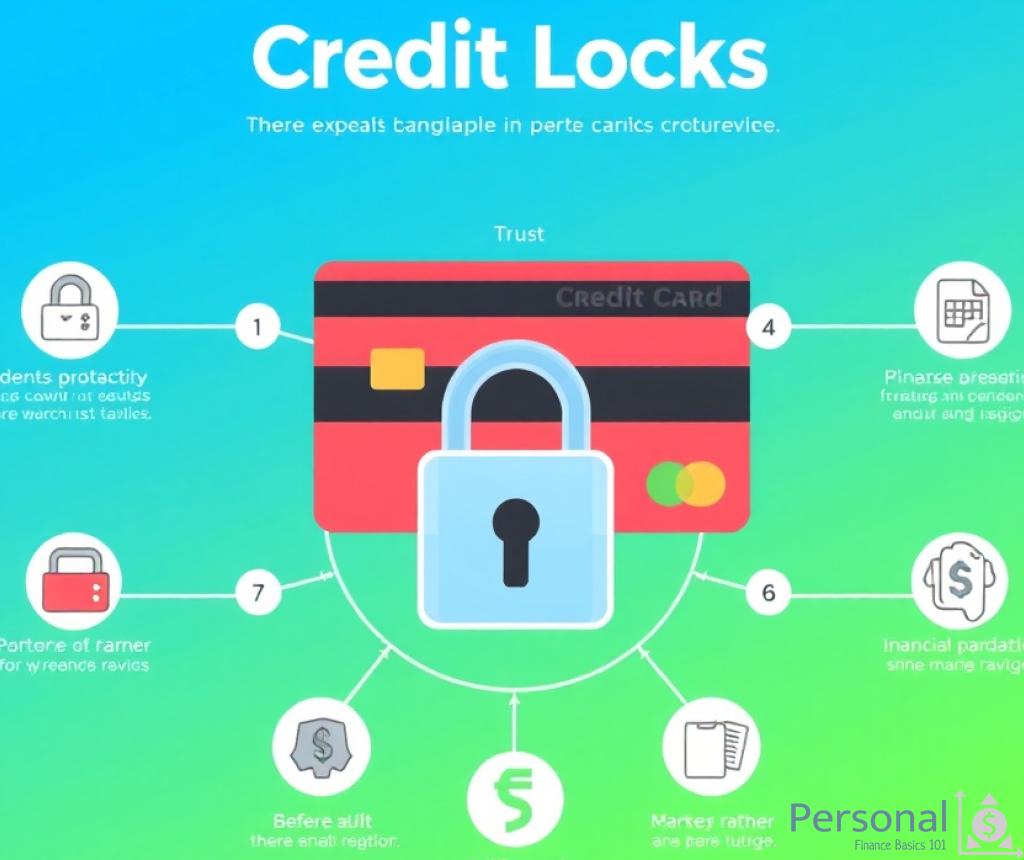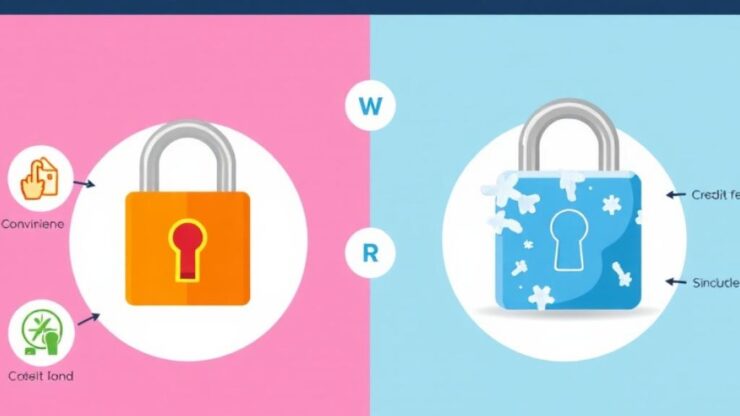Definition and Purpose of Credit Locks

Credit locks are a relatively modern tool designed to help consumers take control of their credit information. Unlike traditional credit freezes, which have been around for years, credit locks can be activated and deactivated swiftly, offering a more flexible approach to protecting your identity. This feature is particularly appealing for those who are tech-savvy and prefer real-time management of their credit profile.
The primary purpose of a credit lock is to prevent unauthorized access to your credit report. In an age where identity theft is rampant, having the ability to lock your credit can provide peace of mind. This means that potential lenders cannot access your credit report without your permission, effectively halting any attempts at fraud involving your personal information.
While both credit locks and freezes serve the same fundamental purpose of protecting consumers from identity theft, there are significant differences between the two. Below is a concise comparison:
| Feature | Credit Lock | Credit Freeze |
|---|---|---|
| Activation Speed | Instant | 1-3 Days |
| Access | Mobile App/Online | Phone/Online with PIN |
| Cost | Usually Free | Free |
| Ease of Use | More User-Friendly | Less Convenient |
In summary, credit locks offer a more user-friendly experience, allowing for immediate control over your credit report. This makes them an attractive option for consumers seeking a balance between security and convenience.
Definition and Purpose of Credit Freezes
As consumers navigate the complexities of personal finance, understanding the tools available for credit protection is essential. One such tool, the credit freeze, serves as a formidable barrier against identity theft, providing an extra layer of security for your financial information.
A credit freeze, also known as a security freeze, is a legal mechanism that restricts access to your credit report. By placing a freeze, you ensure that lenders cannot view your credit profile without your explicit consent. This precaution is especially crucial in a time when data breaches and cybercrime are prevalent.
When you initiate a credit freeze, you must contact each of the three major credit bureaus—Experian, TransUnion, and Equifax. The freeze is implemented almost immediately but may take up to a few days to reflect across all bureaus. To lift the freeze temporarily or permanently, you will need to provide a unique PIN or password that was assigned to you during the initiation process.
Understanding the specific advantages associated with credit freezes can empower consumers to make informed decisions:
- Enhanced Security: By restricting access to your credit report, you effectively safeguard against unauthorized credit inquiries that could lead to identity theft.
- Control Over Credit Access: A credit freeze puts you in the driver’s seat, allowing only authorized parties to access your credit information.
- Cost-Free Protection: Implementing a credit freeze is free of charge, making it a financially viable option for all consumers.
In summary, a credit freeze is a proactive measure that offers substantial protection against identity theft, ensuring your financial history remains secure. While it may not provide the same level of immediate flexibility as a credit lock, its robust security features make it a critical tool for consumers looking to protect their financial identity.
Key Differences Between Credit Locks and Freezes
As consumers become increasingly aware of the importance of protecting their personal information, the tools available to safeguard credit profiles have garnered significant attention. Understanding the key differences between credit locks and credit freezes is essential for consumers who want to make informed decisions about their financial security. While both mechanisms serve the purpose of shielding your credit report from unauthorized access, they differ markedly in their implementation, accessibility, and overall user experience.
Activation and Accessibility
One of the most notable differences between credit locks and freezes lies in the activation process. Credit locks offer a distinct advantage in terms of speed and convenience. Users can easily activate or deactivate their credit lock through a mobile app or online platform within mere moments. This instant accessibility empowers individuals to manage their credit profile in real-time, making it a highly appealing option for those who prioritize immediate control over their financial information. Conversely, initiating a credit freeze requires contacting each of the three major credit bureaus—Experian, TransUnion, and Equifax—and may take up to several days to fully implement across all platforms. While both serve to protect your credit, the time factor could be a decisive element for many consumers.
Cost and Ease of Use
When it comes to financial tools, cost is a significant consideration. Generally, both credit locks and freezes are free services; however, the user experience diverges notably. Credit locks are designed to be more user-friendly, allowing for seamless adjustments at any time via an intuitive interface. This ease of use is particularly beneficial for tech-savvy individuals who appreciate the ability to manage their credit quickly and efficiently. In contrast, credit freezes, while equally effective in preventing unauthorized access, often require more steps and the use of a PIN or password every time access needs to be lifted, which can be cumbersome for some users.
Security and Control
While both options provide a robust layer of protection against identity theft, the mechanisms behind each offer varying degrees of security control. A credit freeze serves as a legal barrier, requiring consumers to take the extra step of contacting credit bureaus, thus ensuring that only authorized parties can access their credit report. This can offer a sense of reassurance for those who prefer a more formalized approach to credit security. On the other hand, credit locks, despite their ease of use, may not carry the same legal weight as freezes, which may leave some consumers questioning the level of protection they provide. Ultimately, understanding these nuances can guide consumers in selecting the most appropriate option for their unique needs.
How to Implement Credit Locks and Freezes
In an era where safeguarding personal information is paramount, knowing how to effectively implement credit locks and freezes is crucial. Both options serve as protective measures against identity theft, yet their processes differ significantly. Understanding these methods will empower consumers to take decisive action in securing their financial identity.
Activating a credit lock is a straightforward process that can be accomplished in just a few steps. The convenience of mobile apps and online platforms makes it accessible for individuals who prefer instant control over their credit profile. Below is a step-by-step guide on how to lock your credit:
- Select Your Credit Bureau: Choose the bureau where you want to activate the credit lock. The major credit bureaus are Experian, TransUnion, and Equifax.
- Create an Account: If you are a new user, you will need to create an online account with the selected bureau. For existing users, simply log in.
- Locate the Credit Lock Feature: Navigate to the section dedicated to credit protection services and select the credit lock option.
- Activate Your Lock: Follow the prompts to lock your credit. This typically involves confirming your identity and agreeing to the terms of service.
- Monitor Your Credit: Regularly check your credit report for any changes or unauthorized activity.
While a credit freeze offers enhanced security, the implementation process requires a bit more effort. Below is a guide on how to effectively freeze your credit:
- Contact Each Credit Bureau: You must reach out to each of the three major credit bureaus individually—Experian, TransUnion, and Equifax.
- Provide Personal Information: Be prepared to submit personal information, including your Social Security number, date of birth, and address.
- Receive a PIN: Upon placing a freeze, you will receive a unique PIN or password. This will be necessary to lift the freeze later on.
- Verify the Freeze: It is important to verify that your credit report has been successfully frozen by checking with each bureau.
- Keep Your PIN Secure: Store your PIN in a safe place, as it is essential for temporarily lifting or permanently removing your freeze.
In summary, while both a credit lock and a credit freeze serve to protect your financial information, their implementation processes differ. Credit locks offer a more user-friendly experience, while freezes provide a robust security measure that requires direct interaction with credit bureaus. Ultimately, understanding how to implement each option allows consumers to choose the best method for their individual needs.
Impact on Credit Reports and Scores
When navigating the landscape of credit protection, understanding how credit locks and freezes influence your credit reports and scores is vital. Both mechanisms are designed to enhance security against identity theft, yet their effects on your credit profile can differ significantly. This knowledge is crucial for consumers who may be concerned about how these protective measures interact with their overall creditworthiness.
Credit Locks and Their Effect on Credit Scores
Credit locks are generally perceived as a flexible tool for safeguarding your credit information. When you activate a credit lock, it does not directly impact your credit score. This is because a credit lock merely restricts access to your credit report without altering the underlying data. As such, lenders cannot perform credit inquiries during the lock period, which means that your credit score remains unchanged unless there are other factors at play, such as changes in your credit utilization or payment history. However, the ability to lock and unlock your credit report instantly can empower consumers to manage their credit proactively, thereby potentially enhancing their credit score over time by ensuring timely payments and responsible credit use.
The Security Freeze’s Role in Credit Reporting
On the other hand, a credit freeze also does not have a direct effect on your credit score. Much like a credit lock, a freeze restricts access to your credit report, preventing lenders from conducting inquiries that could result in new credit being opened in your name without your consent. The primary distinction lies in the fact that a credit freeze is a more formalized process, typically requiring a PIN to lift the freeze for potential lenders. This added layer of security may provide consumers with a sense of reassurance, knowing that their credit report is securely protected. While neither mechanism affects the credit score directly, the implications of securing your credit information can lead to better financial habits, which ultimately reflect positively in your credit report.
Considerations for Consumers
As consumers weigh their options between credit locks and freezes, it is essential to consider how these tools align with their financial goals. For individuals actively seeking new credit, a credit lock might offer the flexibility needed to apply for loans or credit cards while maintaining security. Conversely, for those who prioritize stringent control over their credit profile, a credit freeze can serve as a powerful deterrent against unauthorized access. Understanding how both mechanisms operate in relation to credit reports and scores can empower consumers to make informed decisions that secure their financial future.
Disclaimer
This article has been created or edited with the support of artificial intelligence and is for informational purposes only. The information provided should not be considered investment advice. Please seek the support of a professional advisor before making any investment decisions.






